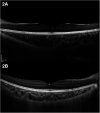Assessment of choroidal vascularity and choriocapillaris blood perfusion in Chinese preschool-age anisometropic hyperopic amblyopia children
- PMID: 36467467
- PMCID: PMC9713412
- DOI: 10.3389/fped.2022.1056888
Assessment of choroidal vascularity and choriocapillaris blood perfusion in Chinese preschool-age anisometropic hyperopic amblyopia children
Abstract
Purpose: To determine the macular and peripapillary area choroid microstructure parameters of hyperopic anisometropic amblyopia eyes and compare to fellow and age-matched control eyes. To assess the correlation between the axial length (AL), choroidal thickness (CT) and choroid microstructure parameters.
Methods: This cross-sectional comparative, non-interventional study involved 52 hyperopic anisometropic amblyopia children and 48 age-matched heathy controls. 52 eyes with hyperopic anisometropic amblyopia and 48 age-matched control eyes were studied. The peripapillary and subfoveal CT were determined. The total choroidal area (TCA), luminal area (LA), and stromal area (SA) of the subfoveal and peripapillary choroid were measured. In addition, the correlation between the AL, CT and choroid microstructure parameters were calculated.
Results: The peripapillary and subfoveal CT of the amblyopic eyes was significantly thicker than the fellow and control eyes (all P < 0.05). The subfoveal and peripapillary choroidal SA, LA and TCA of the amblyopic eyes were significantly increased than that of the fellow and control eyes (all P < 0.05). The choroidal vascularity index (CVI) values of the amblyopic eye were significantly different among the three groups (P < 0.05). There was a statistically significant negative correlation between AL and subfoveal CT (SFCT), LA and TCA levels (P < 0.001, P = 0.039, P = 0.027, respectively). Spherical equivalent (SE) was positive correlated with SFCT, LA and TCA levels (P = 0.456, 0.229 and 0.240, respectively; all P < 0.05). There was a statistically significant positive correlation between SFCT, SE, LA, SA, TCA and CVI levels (all P < 0.05).
Conclusion: The subfoveal and peripapillary CT of amblyopic children abnormally increased and correlated with shorter AL and higher SE. The choroidal structure of the amblyopic eyes was different from the fellow and control eyes, the hyperopic anisometropic amblyopic eyes had significantly thicker sub-foveal choroid, higher LA, SA, and TCA. AL and CT affect choroidal structure and vascular density. Choroidal blood flow may be increased in amblyopic eyes. The larger LA, SA, TCA, and lower CVI were characteristic of the amblyopic eye.
Keywords: amblyopia; anisometropic; choriocapillaris blood perfusion choroidal thickness; choroidal vascularity index; hyperopia.
© 2022 Hui, Xiaofeng, Hua, Yihan and Yong.
Conflict of interest statement
The authors declare that the research was conducted in the absence of any commercial or financial relationships that could be construed as a potential conflict of interest.
Figures





Similar articles
-
Choroidal vascular characteristics in anisometropic amblyopia: a comparative analysis.BMC Ophthalmol. 2025 May 21;25(1):301. doi: 10.1186/s12886-025-04143-3. BMC Ophthalmol. 2025. PMID: 40399854 Free PMC article.
-
How does anisometropia affect the choroidal vascularity index?Indian J Ophthalmol. 2022 Jun;70(6):2043-2049. doi: 10.4103/ijo.IJO_3092_21. Indian J Ophthalmol. 2022. PMID: 35647979 Free PMC article.
-
Subfoveal Choroidal Thickness and Axial Length in Preschool Children with Hyperopic Anisometropic Amblyopia.Curr Eye Res. 2015 Sep;40(9):954-61. doi: 10.3109/02713683.2014.964418. Epub 2014 Oct 20. Curr Eye Res. 2015. PMID: 25330225
-
A Meta-Analysis of Choroidal Thickness Changes in Unilateral Amblyopia.J Ophthalmol. 2017;2017:2915261. doi: 10.1155/2017/2915261. Epub 2017 Jun 19. J Ophthalmol. 2017. PMID: 28751980 Free PMC article. Review.
-
Effects of cigarette smoking on retinal thickness and choroidal vascularity index: a systematic review and meta-analysis.Int J Retina Vitreous. 2025 Feb 26;11(1):21. doi: 10.1186/s40942-025-00646-9. Int J Retina Vitreous. 2025. PMID: 40012012 Free PMC article. Review.
Cited by
-
Myopia Is an Ischemic Eye Condition: A Review from the Perspective of Choroidal Blood Flow.J Clin Med. 2024 May 9;13(10):2777. doi: 10.3390/jcm13102777. J Clin Med. 2024. PMID: 38792319 Free PMC article. Review.
-
Choroidal vascular characteristics in anisometropic amblyopia: a comparative analysis.BMC Ophthalmol. 2025 May 21;25(1):301. doi: 10.1186/s12886-025-04143-3. BMC Ophthalmol. 2025. PMID: 40399854 Free PMC article.
References
LinkOut - more resources
Full Text Sources

